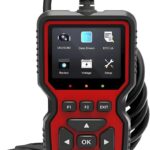An Obd2 To Db15 Cable is an essential tool for connecting certain diagnostic equipment to a vehicle’s OBD2 port. This article provides a comprehensive overview of this specialized cable, its applications, and key considerations.
Understanding the OBD2 to DB15 Cable
The OBD2 (On-Board Diagnostics II) port is a standardized 16-pin connector found in most vehicles manufactured after 1996. It allows access to vehicle diagnostic data for troubleshooting and maintenance. However, some older or specialized diagnostic tools utilize a DB15 connector, a 15-pin connector commonly used in computer and communication technologies. The OBD2 to DB15 cable bridges this gap, enabling these tools to interface with modern vehicles. This cable essentially converts the DB15 interface of the diagnostic tool to the standardized OBD2 16-pin interface of the vehicle.
Applications of the OBD2 to DB15 Cable
The primary application of the OBD2 to DB15 cable is to facilitate vehicle diagnostics using equipment with a DB15 interface. This is particularly relevant for:
- Legacy Diagnostic Tools: Many older diagnostic scanners and code readers utilize the DB15 connector. The OBD2 to DB15 cable allows these tools to remain functional with modern vehicles, extending their lifespan and avoiding the need for costly replacements.
- Specialized Equipment: Certain specialized automotive equipment, such as programming or flashing tools, might utilize a DB15 interface. This cable provides the necessary connection for these tools to interact with the vehicle’s OBD2 system.
- Launch Tech Diagnostic Tools: Specifically designed for Launch Tech diagnostic tools like the Launch Creader Y R981 CR982 CR971 CR972.
Key Considerations When Choosing an OBD2 to DB15 Cable
Selecting the right OBD2 to DB15 cable is crucial for ensuring compatibility and reliable performance:
- Compatibility: Verify that the cable is specifically designed for your diagnostic tool and vehicle. Different manufacturers may have unique pin configurations. Confirm compatibility with Launch Tech devices if required.
- Quality and Durability: Opt for a cable constructed with high-quality materials and robust connectors. This ensures durability and longevity, especially in a workshop environment. Look for features like gold or nickel-plated brass pins and durable cable jacketing (e.g., PE, PP, SR-PVC).
- Cable Length: Choose a cable length that provides sufficient reach for comfortable operation without excessive slack. Customized cable lengths are often available.
Ensuring a Secure Connection
When using an OBD2 to DB15 cable, ensure a secure connection to both the diagnostic tool and the vehicle’s OBD2 port. A loose connection can lead to communication errors or interrupted data transmission.
Conclusion
The OBD2 to DB15 cable serves as a vital bridge between older or specialized diagnostic equipment and modern vehicles. By understanding its function and key considerations, users can ensure accurate diagnostics and efficient vehicle maintenance. Choosing a high-quality cable designed for your specific needs is paramount for reliable performance and longevity. Always verify compatibility with your diagnostic tool before purchasing. For specific use with Launch diagnostic equipment, confirm compatibility with the manufacturer or reseller.

